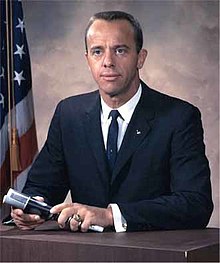Alan B. Shepard Jr.
| Alan Shepard | |
|---|---|
 |
|
| NASA astronaut | |
| Nationality | American |
| Born | Alan Bartlett Shepard Jr. November 18, 1923 Derry, New Hampshire, U.S. |
| Died | July 21, 1998 (aged 74) Pebble Beach, California, U.S. |
|
Other occupation
|
Naval aviator, test pilot |
|
United States Naval Academy (B.S., 1944) Naval War College (M.A., 1957) |
|
| Rank |
|
|
Time in space
|
9d 00h 57m |
| Selection | 1959 NASA Group 1 |
|
Total EVAs
|
2 |
|
Total EVA time
|
9 hours 23 minutes |
| Missions | MR-3, Apollo 14 |
|
Mission insignia
|
|
| Retirement | August 1, 1974 |
| Awards |
Navy Distinguished Service Medal Distinguished Flying Cross Congressional Space Medal of Honor NASA Distinguished Service Medal (2) NASA Exceptional Service Medal |
Rear Admiral Alan Bartlett Shepard Jr. (November 18, 1923 – July 21, 1998) was an American astronaut, naval aviator, test pilot, and businessman.
A graduate of the United States Naval Academy at Annapolis, Shepard saw action with the surface navy during World War II. He became a naval aviator in 1946, and a test pilot in 1950. He was selected as one of the original NASA Mercury Seven astronauts in 1959, and in May 1961 he made the first manned Project Mercury flight, MR-3, in a spacecraft he named Freedom 7. His craft entered space, but did not achieve orbit. He became the second person, and the first American, to travel into space, and the first person to manually control the orientation of his spacecraft. In the final stages of Project Mercury, Shepard was scheduled to pilot the Mercury-Atlas 10 (MA-10), which was planned as a three-day mission. He named Mercury Spacecraft 15B Freedom 7 II in honor of his first spacecraft, but the mission was cancelled.
Shepard was designated as the commander of the first manned Project Gemini mission, but was grounded in 1963 due to Ménière's disease, an inner-ear ailment that caused episodes of extreme dizziness and nausea. This was surgically corrected in 1969, and in 1971, Shepard commanded the Apollo 14 mission, piloting the Apollo Lunar Module Antares to the most accurate landing of the Apollo missions. At age 47, he became the fifth and oldest person to walk on the Moon, and the only one of the Mercury Seven astronauts to do so. During the mission, he hit two golf balls on the lunar surface. He was Chief of the Astronaut Office from November 1963 to July 1969 (the approximate period of his grounding), and from June 1971 until his retirement from the United States Navy and NASA on August 1, 1974. He was promoted to rear admiral on August 25, 1971, the first astronaut to reach that rank.
...
Wikipedia
